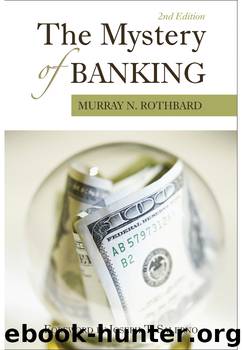The Mystery Of Banking by Murray N. Rothbard

Author:Murray N. Rothbard [Rothbard, Murray N.]
Language: eng
Format: epub, mobi
Publisher: Ludwig von Mises Institute
FIGURE 11.5 — THE SECOND BANK EXPANDS
FIGURE 11.6 — THE SECOND AND THIRD BANKS
Clearly, what happens is a repeat of what happened to Banks A and B, as seen in Figure 11.4. When the Bank of Great Neck cashed in $640 in reserves from ChemBank, it left ChemBank with $160 worth of reserves, just enough to satisfy the 20 percent reserve requirement from Smith’s demand deposits. In the same way, Citibank was left with $200, just enough to meet the reserve requirement for the increased demand deposit of $1,000 to Jones & Co. Bank B is now out of the picture, having contributed $800 to the expansion of the money supply, just as Bank A is out of the picture, having received the initial impact of $1,000 of new reserves on the banking system. Bank C is now, after the operations of this process, in the same position as Banks A and B had been before, except it now has fewer new reserves, in this case $640.
We can now sum up the results of the process so far, looking, in Figure 11.7, at the balance sheets for Banks A, B, and C, as well as the Federal Reserve Bank.
Thus we see that any increase in reserves (whether from increased deposits of cash, loans by the Fed, or open market purchase) must take place in one particular bank. That bank, in a competitive banking system, cannot itself increase its loans and deposits by the money multiplier. But it can and does expand by 1 minus the reserve requirement, in our example 80 percent. As it does so, the process of bank credit expansion has a ripple effect outward from the initial bank. Each outward ripple is less intense. For each succeeding bank increases the money supply by a lower amount (in our example, Bank A increases demand deposits by $1,000, Bank B by $800, and Bank C by $640), each bank increases its loan by a lower amount (Bank A by $800, Bank B by $640), and the increased reserves get distributed to other banks, but in lesser degree (Bank A by $200, Bank B by $160).
The next step will be for Bank C to expand by 80 percent of its new reserves, which will be $512. And so on from bank to bank, in ever decreasing ripple effects. As the ripples widen, each bank in the process will increase its demand deposits by 80 percent of the preceding bank’s.
Download
This site does not store any files on its server. We only index and link to content provided by other sites. Please contact the content providers to delete copyright contents if any and email us, we'll remove relevant links or contents immediately.
International Integration of the Brazilian Economy by Elias C. Grivoyannis(90794)
The Radium Girls by Kate Moore(11921)
Turbulence by E. J. Noyes(7935)
Nudge - Improving Decisions about Health, Wealth, and Happiness by Thaler Sunstein(7615)
The Black Swan by Nassim Nicholas Taleb(7010)
Rich Dad Poor Dad by Robert T. Kiyosaki(6399)
Pioneering Portfolio Management by David F. Swensen(6226)
Man-made Catastrophes and Risk Information Concealment by Dmitry Chernov & Didier Sornette(5921)
Zero to One by Peter Thiel(5685)
Secrecy World by Jake Bernstein(4643)
Millionaire: The Philanderer, Gambler, and Duelist Who Invented Modern Finance by Janet Gleeson(4374)
The Age of Surveillance Capitalism by Shoshana Zuboff(4209)
Skin in the Game by Nassim Nicholas Taleb(4161)
Bullshit Jobs by David Graeber(4094)
The Money Culture by Michael Lewis(4076)
Skin in the Game: Hidden Asymmetries in Daily Life by Nassim Nicholas Taleb(3929)
The Dhandho Investor by Mohnish Pabrai(3698)
The Wisdom of Finance by Mihir Desai(3650)
Blockchain Basics by Daniel Drescher(3504)
